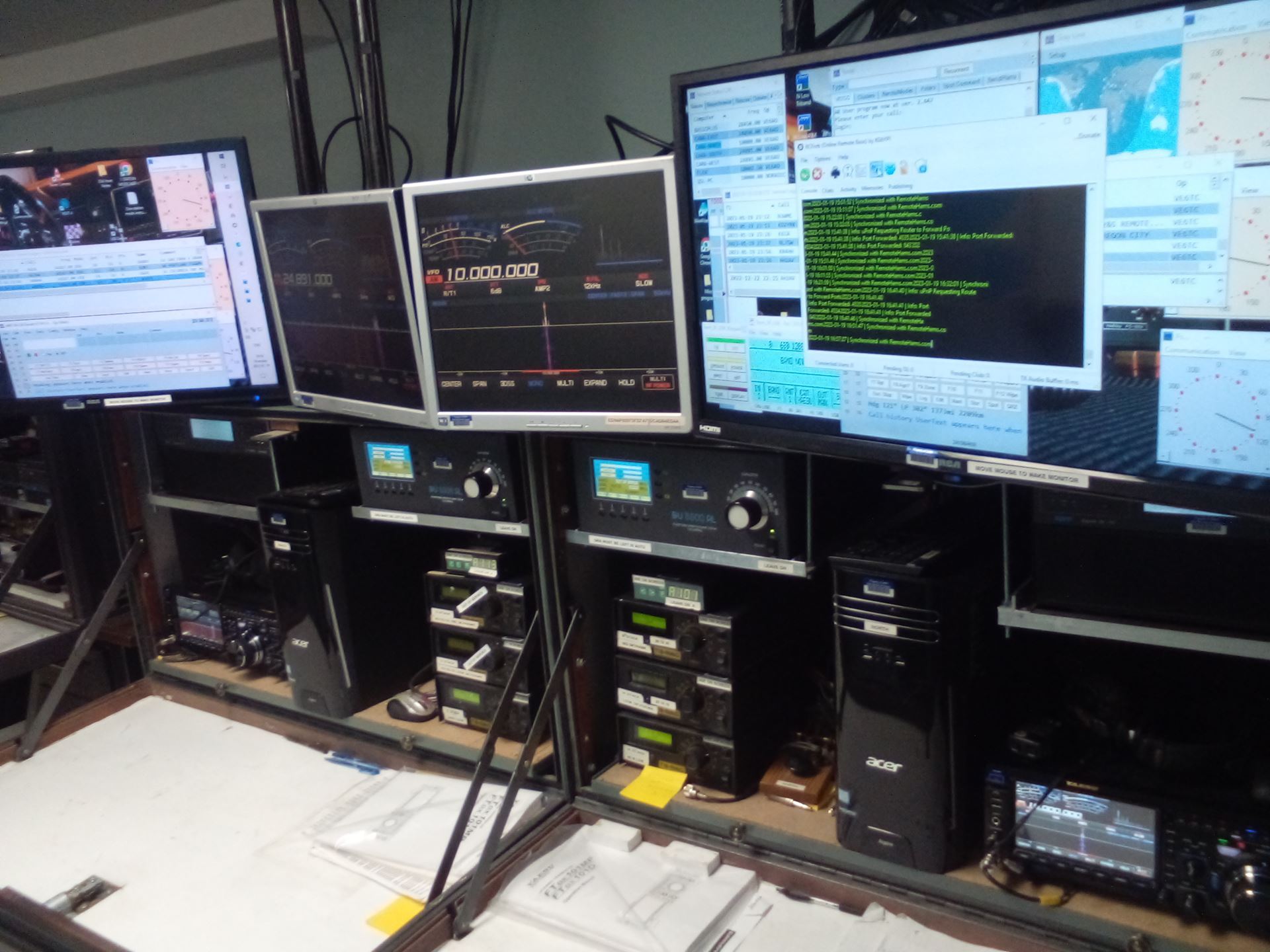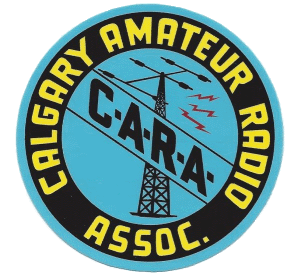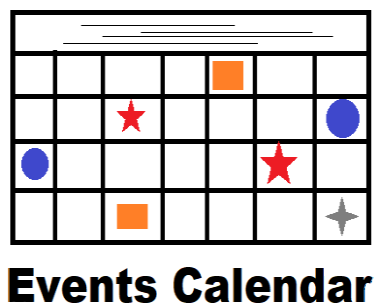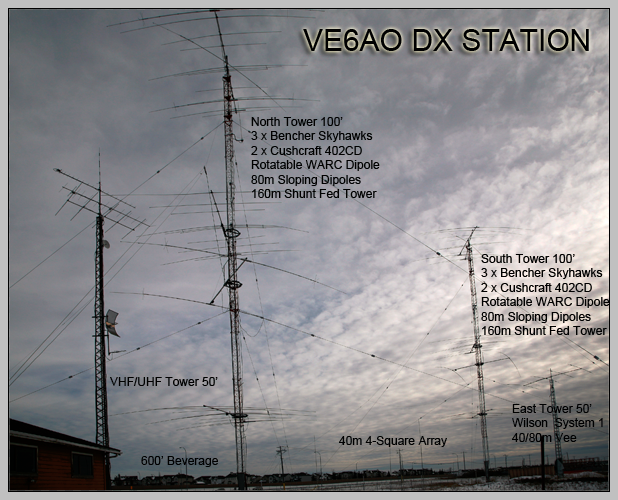- Home
- Operating
- Station VE6AO
- Station Overview 'VE6AO'
Station Overview 'VE6AO'
Station Status: Available for in person and remote use. Contact the Club Station Team at stationteam@caraham.org if you would like to visit or operate the station.
The club station is available to members to explore DXing, contesting and casual station operation on the HF, VHF and UHF bands using SSB, CW, RTTY, FT8, PSK, packet and other digital modes.

The club station's HF operating positions are named by tower location. The North station uses the north most 100 ft tower and the operating position is next to the window. To the left of it is the South station, which uses the south most 100 ft tower. The East, West, Flex and Basic+ stations fill the rest of the radio room within similar operating cabinets.
The club station VE6AO is activated during major contests, normally in the multi-single or multi-two categories and occasionally, multi-multi. The two main North and South stations consist of Yaesu FTDX101D transceivers, DU3500AL tuners and Expert 2KFA solid state amplifiers. Heil boom headsets with HC-4 cartridges are used along with footswitches on SSB and Bencher paddles for CW. Hamation CR-5 CAT routers distribute the CAT control from the rig to the amplifiers, tuners and software.
Auto band-switched Dunestar 600 filters, using Top Ten band decoders, keep the inter-station interference to a minimum.
Antennas on North and South 100 ft tower are three independently rotatable Bencher Skyhawks for 10/15/20 @ 101ft, 60ft and 30ft, two Cushcraft 402 CD for 40 meters @ 105 ft and 50 ft and a Cushcraft rotatable WARC dipole fixed to the legs of the towers around 90 ft. A WX0B 3 position stackmatch is used to phase the 3 tribanders and a 2 position stackmatch phases the two 40 meter beams.
Tic ring rotors turn the middle and lower triband yagis as well as the lower 40 meter beam. An Alpha Spid rotator turns the top tribander and 40 meter beam. A ring of 30, 100 ft radials are attached to the ground system to support shunt feeding of the towers, as a vertical on 160 meters.
Another 2 port WX0B stackmatch allows the antennas on both towers to be combined and fed in phase the single operator mode. A pair of relays switches the North station from the two operator to single operator configuration, resulting in 6 tribanders on 10/15/20 and 4 2 el monobanders on 40, with 40 M spacing between the two stacks of antennas.
The two towers, ¼ wave apart, can be operated as phased verticals on 160 meters using a WX0B 160M phasing box.
The third HF position is known as the "East" station. It has an FT2000 radio and Alpha 9500 amplifier, which auto selects a 10/15/20 M System One tribander on a 50 ft tower or an 40/80 M fan dipole in an inverted V configuration.
A Flex 5000 HF transceiver is also available for use with a vertical antenna and MFJ tuner.
In addition to HF, there are two VHF/UHF operating positions. One position is primarily used for weak signal long distance VHF communications. A Kenwood TS-2000 is remote controllable for operation on HF, 6m, 2m and 70 cm, in conjunction with KW level power amplifiers and wire antennas on a 60 ft tower. A loop yagi was added for 1296 Mhz CW and SSB operation.
Several VHF radios are available on the second VHF position, with vertical antennas on the North 100 foot and 60 ft VHF towers, which operate FM, DSTAR and DMR on 146, 223, 446 and 902 Mhz.
A satellite & FM station using an Icom IC-9700 with a computer controlled azimuth and elevation controlled Yaesu rotor allow 2M and 70 cm satellite operation and 1296 Mhz FM. An Icom IC-7300 completes this Basic+ station, allowing HF operation with a Yaesu FL-7000 solid state amplifier, soon to be replaced by an Icom IC-2KL solid state 500W amplifier.
The station's networked computers are used for logging using N1MM contest logging software. The operating positions normally connect to the local packet cluster through a cable Internet connection, thereby providing DX spots on the computer logging software for the band in use.
Wireless computer networking is available in the building and web cams monitor the doors and radio shack along with elaborate entry and security systems. Members and amateurs visiting Calgary are encouraged to contact the Club Station Team at stationteam@caraham.org to arrange a visit.
In 1998, CARA applied to the Calgary Community Lottery Board for a grant and received a $15,000 grant, which was used to purchase and install the first 100' commercial guyed tower. Later funding has allowed development of the stations to their current state. CARA thanks the Calgary Community Lottery Board for its generosity and the Alberta Government’s Liquor and Gaming Commission’s charitable gaming program, for their continuing support.
VE6AO - AMATEUR RADIO STATION CHARITABLE PROGRAM - AID TO THE DISTRESSED
CARA’s amateur radio station VE6AO, currently located in two leased basement rooms on about 2 acres at the Calgary Sports Car Club, provides local, regional, provincial, national, continental and worldwide shortwave, vhf, uhf and satellite two way amateur radio communications infrastructure and trained radio operators that can be used to provide emergency communications to aid victims of disasters or sudden catastrophes, when normal communications are interrupted.
CARA’s station team designs, constructs, maintains and improves the station equipment using casino funds and trains radio operators in its use, to help ensure its availability during an emergency.
Club members regularly check in to daily local and regional amateur radio shortwave networks, set up to facilitate regular and emergency communications through the passing of formatted amateur radio messages. Participation in formal, controlled radio networks provides good training for emergency network participation, when required.
Daily station use by club members, both in person and remotely over the internet, as well as monthly radio contests, where short formatted messages are exchanged between stations, help maintain a pool of trained radio operators both familiar with the equipment and with the stamina and accuracy to endure extended radio operations over 24 or 48 hour contest weekends, similar to extended disaster situations.
The station is activated yearly for an extended period during the two weeks of the Calgary Stampede as a special event station, where we tell other radio operators around the world about the Stampede. These extended events test the resilience of station equipment and radio operators and often identify issues to be resolved to maintain station availability. A multi-station strategy, with radio and antenna redundancy on site, help increase availability, in preparation for emergency use.
The station was activated during an actual emergency during the Calgary floods, when Calgary ARES (Amateur Radio Emergency Service) and club members operated the station as the Calgary EOC (Emergency Operations Center) both locally on VHF within the City and throughout Albert on shortwave, linking emergency coordinators in Edmonton with other radio operators supporting the flood relief communications in other affected communities along the Bow River. The station is also used by school groups, cubs, boy scouts and girl guides for annual class trips, the annual Boy Scout Jamboree on the Air and Guides on the Air, to support their educational radio communication programs.
The station houses a commercial Shaw internet connection to CARA’s wireless intranet that links our local area VHF and UHF repeaters and position reporting systems from the mountain parks, which provide radio coverage to support public service events in areas without cell service and emergency communications when required.
A large emergency generator is kept on site to allow operation of both 110 and 220 volt station and support equipment during an extended power outage. Individual UPS (Uninterruptable Power Supply) on each radio operating position provide short term power backup during short power outages, mainly for the computer equipment.
In addition to the radio station equipment, an electronic workbench, with a variety of test and repair tools and competent radio technicians are available to repair station and member equipment, in house, should equipment break down. A microwave and small fridge in the station allow preparation of basic meals to feed radio operators quick meals over an extended period. A regular stove/oven and fridge is also available in the upstairs main kitchen, if required.
YouTube linksLinks to YouTube videos involving VE6AO. |
Accessing VE6AO
Key Fob Agreement
The club station is available to members to explore DXing, contesting and casual station operation on the HF, VHF and UHF bands using SSB, CW, RTTY, PSK, packet and other digital modes.
To gain access to the club station please download and fill out a key fob agreement. Members and non members can visit the station with out a key fob but will have to do so while a member with a fob is there. If you wish to use the station when other members are not on site you will need to fill out this agreement.
You can download the agreement here: CARA Key Fob Agreement.pdf print, fill it out, scan and email it to stationteam@caraham.org. There is a $10 refundable deposit for the key fob.


